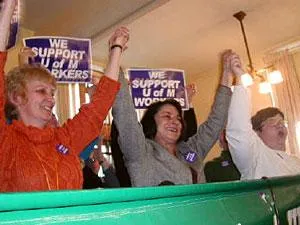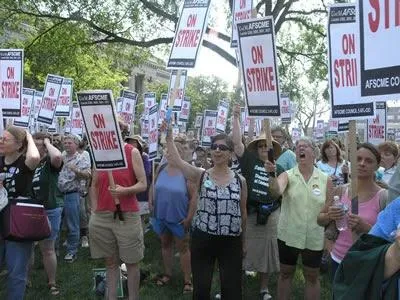History of AFSCME 3800 at the U of M

Pioneers of the Past: A Brief History of AFSCME at the University of Minnesota
By Tom O'Connell and Don J. Dinndorf
AFSCME Council 6 (now Council 5) continued strong growth in the 1980's and 1990's, spurred by aggressive internal organizing, whole new units of public workers at the University of Minnesota. Workers at the University were the last great frontier for Council 6, the last large group of public employees not yet unionized as the 1980's began.
Local 1164, the employees of the University of Minnesota Hospital, had been a part of Council 6 since 1970, but clerical, technical, and professional workers were without union representation. Those 7,000 workers were becoming increasingly aware of the benefits the hospital workers reaped from AFSCME representation as the 1980's began, and in February of 1982, a group known as CUE (Concerned University Employees) recommended AFSCME as the union to conduct an organizing campaign with for clerical employees.
CUE's recommendation was overwhelmingly adopted by its 150 members at the group's March 17th meeting. 82% voted for AFSCME as the union to organize clerical workers over the Teamsters, the Minnesota School Employees Association, and Service Employees International. A campaign began to take shape that spring and summer for Council 6 to organize the Clerical employees of the University of Minnesota.
The campaign took off like a shot. By December of 1982, authorization cards were being circulated among University clerical workers throughout the state by enthusiastic organizers. Bringing the 3,2000 member unit into the AFSCME fold seemed like only a matter of time, and likely a short time at that. Council 6 and AFSCME International lent resources and staff to the growing campaign. Some thought they had enough cards for an election in two months. But ironically, clerical workers at the University of Minnesota Hospital, where hundreds of their fellow workers were AFSCME members, fell short of the necessary 30 percent return to file.
It would be over six years before the campaign would begin again.
In the summer of 1989, growing discontent among non-unionized civil service workers at the University reached a high point. AFSCME- represented workers received a 5 percent pay increase while non-represented workers got just 4 percent. Evelyn Mikes, who had been named Area Office Director six months earlier, said, "That's when the calls and letters really started coming in."
Gladys McKenzie, a former University employee who served as volunteer organizer during the 1982 campaign, was hired as part of a second effort. "People are tired of being short-changed," she said then. "They feel nobody is listening to them and they want a voice."
In January of 1990, AFSCME opened an organizing office in Dinkytown, near the University's main campus in Minneapolis. Authorization cards steadily came in, and scores of workers came forward to assist the effort as volunteers. The effort's profile became higher and higher, as AFSCME shirts, buttons and posters with the slogan "This University Works Because We Do" became ubiquitous across the campuses. There were phone banks, informational meetings, an advertising campaign, and perhaps most valuable of all, one-on-one meetings between organizers and workers throughout the system.
On August 7, 1990, AFSCME filed for an election among the nearly 3,200 clerical workers of the University of Minnesota. The organizing committee alone had now grown to over 300 members. After a vigorous six months, the election took place on February 20, 1991. The University of Minnesota clerical workers overwhelmingly voted AFSCME. The election drew to a close one of the largest public employee organizing drives in state history.

